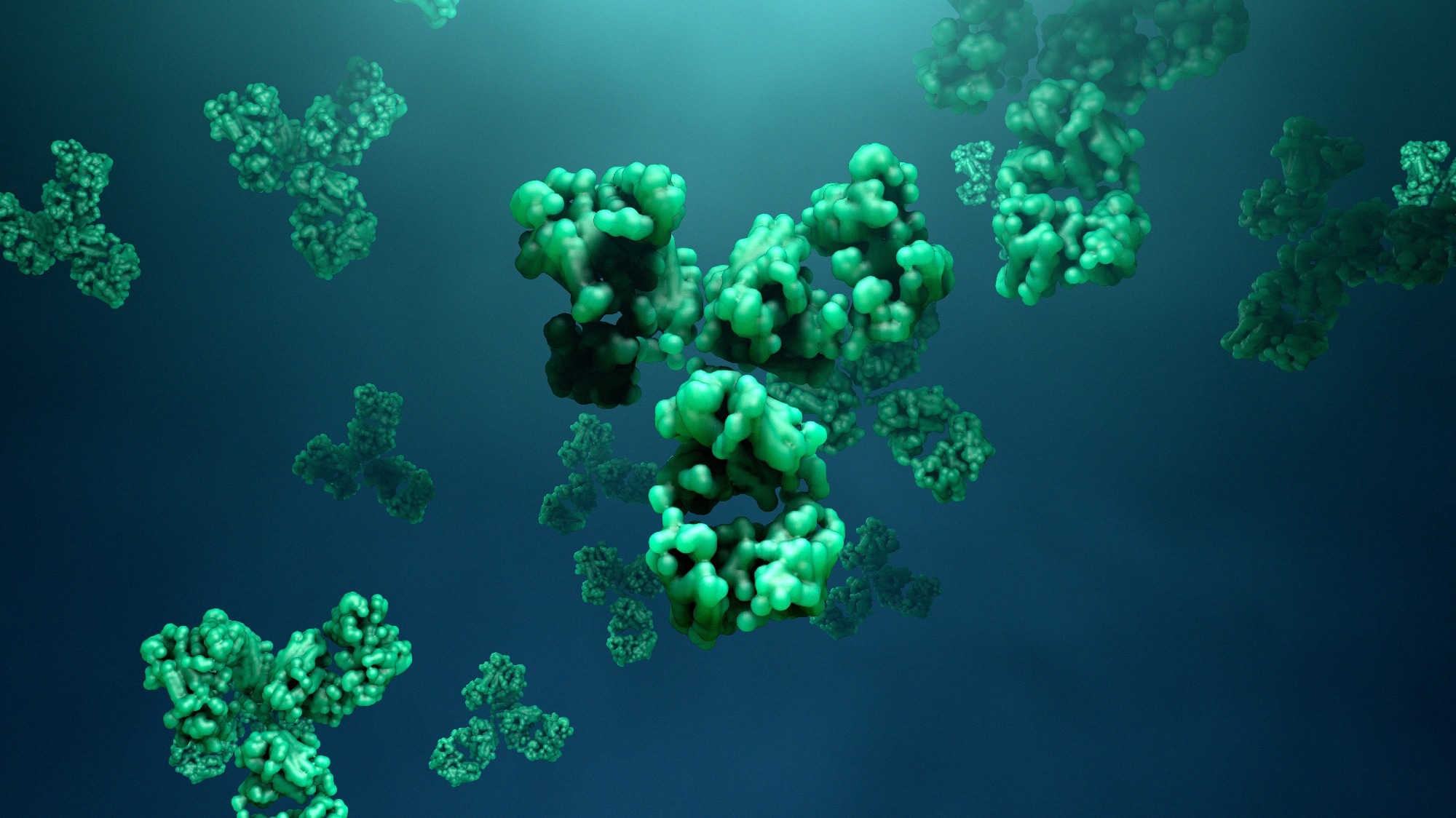In a recent study posted to the bioRxiv* preprint server, researchers in the United States identified a broadly neutralizing antibody (S728-1157 bnAb) that targets the receptor-binding site (RBS) of severe acute respiratory syndrome coronavirus 2 (SARS-CoV-2). S728-1157 bnAb was derived from a SARS-CoV-2-positive individual infected before VOCs (variants of concern) such as Omicron emerged.
The emergence of novel Omicron subvariants has threatened the efficacy of vaccines for coronavirus disease 2019 (COVID-19) and therapeutic agents such as monoclonal antibodies (mAbs). There is an urgent need to develop bnAbs with cross-protective immunity for COVID-19 mitigation. Before Omicron spread, the authors of the present study previously identified 43 monoclonal antibodies targeting distinctive SARS-CoV-2 spike (S) protein epitopes such as the S subunit 2 (S2), receptor-binding domain (RBD) and N terminal domain (NTD); however, none could neutralize all SARS-CoV-2 VOCs existing during the study period.
 Study: Site of vulnerability on SARS-CoV-2 spike induces broadly protective antibody to antigenically distinct omicron SARS-CoV-2 subvariants. Image Credit: Design_Cells / Shutterstock
Study: Site of vulnerability on SARS-CoV-2 spike induces broadly protective antibody to antigenically distinct omicron SARS-CoV-2 subvariants. Image Credit: Design_Cells / Shutterstock
About the study
In the present study, researchers identified a potent SARS-CoV-2 S RBD-targeted bnAb from the peripheral blood of COVID-19 convalescents.
In addition to the previous panel, more RBD-targeted monoclonal antibodies were generated from three individuals with elevated anti-S immunoglobulin G (IgG) titers (high responders). The individuals had significantly greater heavy chain SHRs (somatic hypermutation rates) than low- and mid-responders, indicative of the potent bnAb-generating potential of the high-responders. In addition, the binding of Abs to prime RBD mutant strains was assayed to identify the class types of their epitopes.
Plaque assays and FRNT (focus reduction neutralization test) analyses were performed to assess cross-neutralization of D614G, Alpha, Beta, Delta, Kappa, Mu, and Omicron BA.1/BA.2/BA.2.75/BA.4/BA.5/BL.1. The immunoglobulin heavy (IGHV) and light chain (IGLV) variable genes of the mAbs were compared with the SARS-CoV-2 nAb database.
To identify differences in antigenicity between the 2P (diproline) and 6P (hexaproline) S protein constructs, the corresponding immunogens were added to the RBD-targeted mAbs panel, and enzyme-linked immunosorbent assays (ELISA) and biolayer interferometry (BLI) analyses were performed. For evaluating the protective efficacy of the bnAbs, Syrian hamsters were treated with each mAb post-SARS-CoV-2 infection, and viral loads in their nasal and pulmonary tissues were determined.
Results
Of 14 anti-S RBD mAbs, the team identified four, two, and eight mAbs belonging to class 2, class 3, and to an unclassified category, respectively, that showed a negligible decrease in binding to the prime RBD mutant strains tested. The anti-S RBD mAbs of class 2 or class 3 neither recognized a multivariant artificially designed RBD mutant comprising E484K/K417N/ N501Y/L452R mutations nor was cross-reactive against RBDs of MERS (Middle East respiratory syndrome)-CoV and SARS-CoV-1.
Lab Diagnostics & Automation eBook

Anti-S RBD mAbs of classes 2 and 3 showed potent neutralization of Delta and D614G but neutralized Kappa, Mu and Beta to a limited extent. None of the mAbs of the two classes assayed neutralized the Omicron subvariants. On the contrary, most unclassified Abs showed binding with the artificial multivariant S RBD and cross-reacted with SARS-CoV-1 S RBD. The team identified three broadly neutralizing mAbs, S626-161, S728-1157, and S451-1140, that potently cross-neutralized D614G, Kappa, Beta, Mu, Delta, and the Omicron BA.1 subvariant with IC99 (99% inhibitory concentration) values ranging between 20000 picograms (pg)/ml and 2.5 pg/ml.
In the plaque assay, the S728-1157 mAb showed potent neutralization of Omicron BA.1, Omicron BA.2, and Omicron BA.4/5 (IC99 values of ≤100000 pg/ml). In the FRNT assays, S728-1157 neutralized Omicron BA.2.75, Omicron BL.1, and Omicron BA.4/5 with IC50 (50% inhibitory concentration) values ranging between 8000 pg/ml and 16000 pg/ml. S451-1140 showed potent neutralization of Omicron BA.1, Omicron BA.2, Omicron BA.2.75, and Omicron BL.1, but not the BA.4/5 subvariant, whereas S626-161 could not neutralize any Omicron subvariant except BA.1.
Even though the S626-161 mAb showed lower neutralization of the VOCs compared to S728-1157 and S451-1140, only S626-161 was cross-reactive against RBD of SARS-CoV-1 and could neutralize bat CoVs RsSHC014 and WIV-1. The findings indicated that the S626-161 mAb recognized a preserved epitope shared between the sarbecovirus strains but absent in Omicron BA.2. S728-1157 effectively cross-neutralized all the dominant SARS-CoV-2 strains such as D614G, Alpha, Beta, Delta, Kappa, Mu, and Omicron BA.1/BA.2/BA.2.75/BA.4/BA.5/BL.1.
S728-1157 protected hamsters against in vivo challenges with the wild-type, Delta, and BA.1 strains. Structural analysis findings indicated that the bnAb targeted a class 1 epitope through several polar and hydrophobic interactions with its complementarity-determining regions (CDR)-H1/H2/HR motifs. Only the S728-1157 mAb had unique IGHV and IGLV pairs not reported previously, indicating that it was not a public clonotype. The S728-1157 mAb was bound to the RB site (RBS) and exposed completely when the S RBD was in the ‘up’ configuration. Of importance, the epitope was more readily accessible in the prefusion and open state, or the 6P (hexaproline)-stabilized spike (S) protein constructs, than in the 2P (diproline) constructs.
Overall, the study findings highlighted the broad neutralization width of S728-1157, and the findings could guide the development of targeted anti-SARS-CoV-2 therapeutics. The findings indicated that future COVID-19 vaccines must be modified to present stabilized S in the up conformation for optimal induction of class 1 mAbs with comparable CDR-H3 features and anti-Omicron subvariant efficacy.
*Important notice
bioRxiv publishes preliminary scientific reports that are not peer-reviewed and, therefore, should not be regarded as conclusive, guide clinical practice/health-related behavior, or treated as established information.
- Site of vulnerability on SARS-CoV-2 spike induces broadly protective antibody to antigenically distinct omicron SARS-CoV-2 subvariants. Siriruk Changrob et al. bioRxiv preprint 2022, DOI: https://doi.org/10.1101/2022.10.31.514592, https://www.biorxiv.org/content/10.1101/2022.10.31.514592v1
Posted in: Medical Science News | Medical Research News | Disease/Infection News
Tags: Antibodies, Antibody, Assay, Blood, Coronavirus, Coronavirus Disease COVID-19, covid-19, Efficacy, ELISA, Enzyme, Genes, immunity, Immunoglobulin, in vivo, Omicron, Protein, Receptor, Respiratory, SARS, SARS-CoV-2, Severe Acute Respiratory, Severe Acute Respiratory Syndrome, Syndrome, Therapeutics

Written by
Pooja Toshniwal Paharia
Dr. based clinical-radiological diagnosis and management of oral lesions and conditions and associated maxillofacial disorders.
Source: Read Full Article
